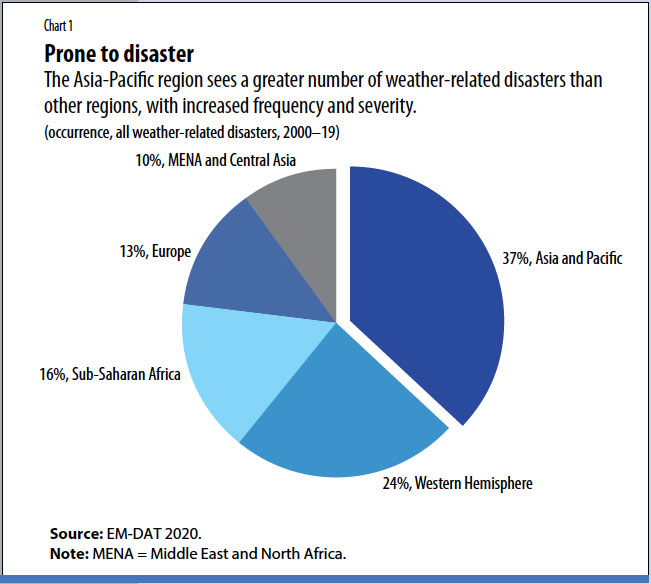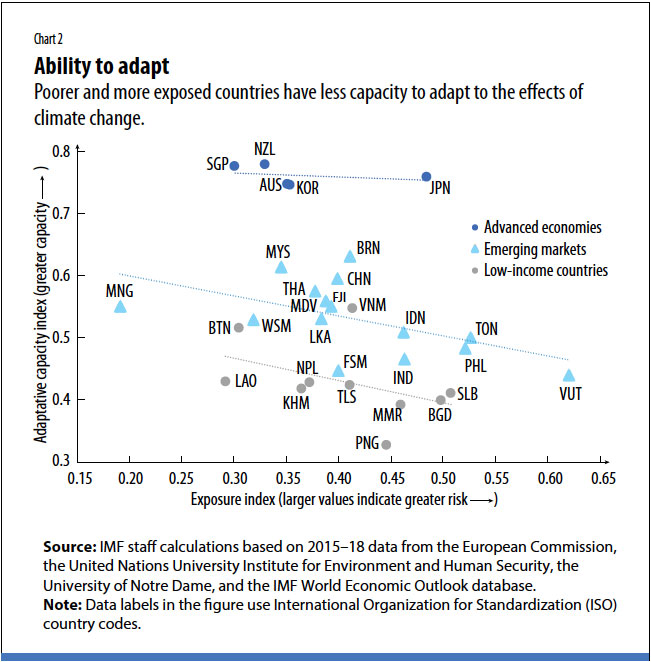Fiscal policy can help address climate change in Asia, the region hit hardest by global warming
Climate change is the defining challenge of our time, and the stakes are particularly high for the Asia-Pacific region. Temperatures are rising two times faster in Asia than the global average, which is associated with the increased frequency and severity of weather-related natural disasters. In 2019 alone, India was buffeted by a severe heat wave that led to water scarcity in parts of the country. Torrential rains in South Asia caused large-scale population displacement, while water levels in the Mekong Delta fell to unprecedented lows due to intense dry weather. Australia faced historic bushfires fueled by a particularly harsh dry season. And more than 25 tropical cyclones wreaked damage on the Pacific and Indian Ocean coasts. Such climate hazards are projected to intensify in the period ahead.
Rising sea levels from global warming are eroding arable land in low-elevation coastal zones, posing a severe risk for rural incomes, food security, and commodity exports. By mid-century, rising waters will impact nearly a billion people in the Asia-Pacific region. Megacities such as Mumbai, Dhaka, Bangkok, Ho Chi Minh City, Jakarta, and Shanghai run the risk of being submerged. Indonesia is already planning to move its heavily populated capital, Jakarta, to the island of Borneo to protect its residents from dangerous flooding. For small Pacific island countries such as Kiribati, the Marshall Islands, and Tuvalu, rising sea levels pose an existential threat.
But while Asia-Pacific suffers keenly from the effects of climate change, the region is also a key source of the problem. The region produces about half of the world’s carbon dioxide (CO2) emissions and contains five of the largest greenhouse-gas-emitting countries. In view of Asia’s substantial share of current emissions as well as its expected future emissions growth, China, India, and other large CO2-emitting countries’ policies to curb emissions will be a critical element of the global effort.
In addition to contributing to global warming, greenhouse gas emissions from Asia’s coal-based power generation and carbon-intensive manufacturing (such as steel and cement, motor vehicles, agriculture, and domestic cooking and heating) have resulted in dangerously high levels of particulate matter in the air (McKinsey Global Institute 2020). Delhi, Dhaka, Ulaanbaatar, Kathmandu, Beijing, and Jakarta are among today’s 10 most polluted cities. The use of fossil fuels must be contained to make a serious dent in air pollution, a major contributor to mortality and respiratory diseases in developing Asia.
Climate change threatens growth, livelihoods, productivity, and well-being across all countries in the region. But fiscal policy can play a role in responding to the problem. In our recent paper, we discuss how policymakers in the Asia-Pacific region can accelerate mitigation and adaptation efforts, using fiscal policy to manage policy trade-offs and ease the transition to a low-carbon economy (Alonso and others 2021).
Preventing further buildup of risks
Much of Asia is already responding to the mitigation challenges of climate change. Virtually all countries have made or updated commitments under the 2015 Paris Agreement, the landmark global agreement on emissions reduction. China recently stated its goal of carbon neutrality (achieving net zero CO2 emissions) before 2060. Japan and Korea have pledged the same goal by 2050. However, more needs to be done to scale up and accelerate the transition to a low-carbon economy. Achieving this ambitious goal calls for changes in production and consumption patterns and the transformation of energy, transportation, and land use.
A carbon tax, where the government taxes carbon emissions, can be an effective tool to reduce CO2 emissions (IMF 2019). Take the case of Vietnam, which has relied heavily on fossil fuels for its rapid industrialization and is also among one of the most hazard-prone countries in the world. Gradually introducing a carbon tax of $25 a ton over the next decade would help the country meet its Paris mitigation targets. Raising the price of carbon would create incentives for firms and households to use energy more efficiently and encourage a shift from coal-powered energy to renewables. Carbon revenues of about 1 percent of GDP could then be used to finance the country’s adaptation and mitigation plans or to meet other social development needs.
Fiscal policy can also help solve the region’s air pollution problem. In China, India, and Mongolia, about 68–80 percent of emissions come from coal. A specific tax on coal produced or consumed at an equivalent carbon tax rate could be considered in these countries. India’s coal tax, introduced in 2010 and doubled in 2020, could be further strengthened. Implementing a coal tax equivalent to $25 a ton could save about three million lives by 2030 in China alone.
A critical part of enabling the transition to a low-carbon economy will be managing potential side-effects, such as rising energy costs for households and firms, labor displacement, and an unequal impact across the regions. But the effects of policies will vary across countries. For example, a carbon tax, if implemented, would be moderately regressive (disproportionately borne by poor) in China and Mongolia, but moderately progressive (disproportionately borne by rich) in India. Countries with a regressive carbon tax must support people—such as coal miners—whose livelihoods depend on energy sector jobs. These workers tend to be relatively poor and may have difficulty transitioning to growing sectors (including renewable plants).
To make up for the negative fallout from the transition, governments will have to find ways to compensate households and firms. In India, for instance, using the revenue from a carbon tax to finance a universal lump sum transfer (possibly using Aadhaar unique identification numbers) would leave 80 percent of households better-off and reduce inequality. In China, both a universal lump-sum transfer per person and a subsidy to rural households would reduce inequality. Displaced workers employed in affected sectors could be supported by extended unemployment benefits, training, and reemployment services. And higher public spending—for instance, on clean public infrastructure—could create new jobs in low-carbon sectors. Governments could also consider putting in place market-based incentives that promote access to green finance to ease financial constraints for firms.
Governments in the region have also adopted a range of other instruments to address climate mitigation including emission trading systems, in which governments set limits on emissions and lets the market determine the price. Currently, emissions trading is limited to power generators and large industries and typically covers only about half of national emissions in most countries in the region—China and Korea, for example. Extending coverage of these systems to small-scale users would help. So would complementary measures such as feebates, which impose a sliding scale of fees or rebates for particular products and activities above or below certain emission rates. Finally, stricter regulations on air quality, fuel quality, and vehicle emission standards would help support decarbonization efforts. Investments in clean public transportation, smart electricity grids to incorporate renewables into power generation, and retrofitting buildings to make them more energy efficient would complement these efforts (IMF 2020).
Accelerating adaptation
Improving the adaptative capacity to offset the damages from more severe climate hazards, more frequent climate-related disasters, or both will be essential for all countries. This will mean developing early warning systems, building resilient infrastructure, reducing exposure, and ensuring that appropriatefinancing mechanisms are in place. Gaps in adaptive capacity, however, remains large for Pacific island countries, such as Vanuatu and Tonga, as well as for developing economies such as Bangladesh, Indonesia, and the Philippines. Adaptation is also likely to entail tough choices about what to protect and what to relocate, as well as how to safeguard the most vulnerable populations.
Loading component...
Despite the challenges, many countries in the region have been at the forefront of adaptation efforts. Japan, Singapore, and Thailand are among the best performers in the world in adopting and implementing frameworks for identifying, assessing, and reducing natural disaster risks. Restoring mangroves, protecting coral reefs, and adopting national and local adaptation plans are among the measures these countries are putting in place. Yet, even in these countries, governments could do more to fully cost and prioritize adaptation plans and factor rising climate risks into infrastructure decisions.
Building adaptive capacity calls for substantial investment, but there are opportunities as well. Developing economies such as Vietnam and Indonesia have large infrastructure needs and growing urban areas. This means they can ensure that what goes up is more resilient and better able to withstand the heightened risks of climate change. New roads could incorporate drainage to withstand heavier rainfall or be built on higher ground to reduce flood risk, a relatively inexpensive solution.
For other countries, bolstering resilience will require retrofitting existing climate-exposed assets or developing coastal protection infrastructure, which can be significantly more costly. Public investment needs for climate-proofing infrastructure are estimated to average 3.3 percent of GDP annually for the region. But the cost of developing coastal protection infrastructure is disproportionately high in many Pacific island countries. In Tonga, for example, climate-related investment needs (of which adaptation investment accounts for a major part) are estimated at 14 percent of GDP annually for 10 years (IMF 2020b). Public investment needs are also sizeable in Indonesia, Laos, and the Philippines, because of their large existing stock of exposed assets. These high costs highlight the urgency of starting to build better to avoid further accumulation of vulnerable assets.
Investing in adaptive infrastructure can yield high returns. It can unlock private capital, including through reducing risk and damage from disasters; limit disaster recovery spending and debt distress; and ensure a quicker rebound in economic activity. But financing adaptation measures is particularly important, given the sheer scale of infrastructure needs for many countries. Revenue mobilization and spending prioritization and efficiency will have to play a role in easing growth-debt trade-offs. For the most vulnerable low-income and Pacific island countries with limited fiscal space, meeting adaptation needs will require concessional financing.
Exploiting synergies
The climate challenge is significant and urgent for the Asia-Pacific region, so governments must seize every opportunity to accelerate adaptation and mitigation work already taking place.
Fiscal packages to jump-start the recovery from COVID-19 should exploit synergies between infrastructure needs and opportunities for emissions reduction and adaptation. Innovation in climate-smart infrastructure and technologies (for example, carbon capture and storage) can help reduce the cost of mitigation. The region is well positioned, as countries such as China and Japan are already at the forefront of innovation—from electric vehicles to renewables. More active promotion of green finance will also help ensure that more money will flow into low-carbon, climate-resilient investments.
Opinions expressed in articles and other materials are those of the authors; they do not necessarily reflect IMF policy.
References:
Alonso, C., V. Balasundharam, M. Bellon, E. Dabla-Norris, C. Chen, D. Corvino, J. Daniel, J. Kilpatrick, and N. Nozaki 2021. Fiscal Policies to Address Climate Change in Asia and the Pacific. Washington, DC: International Monetary Fund.
International Monetary Fund (IMF). 2020a. “Mitigating Climate Change.” World Economic Outlook, Chapter 3. Washington, DC, October.
— — —. 2020b. Tonga: Technical Assistance Report—Climate Change Policy Assessment. IMF Country Report 20/212, International Monetary Fund, Washington, DC.
McKinsey Global Institute. 2020. Climate Risk and Response in Asia.












